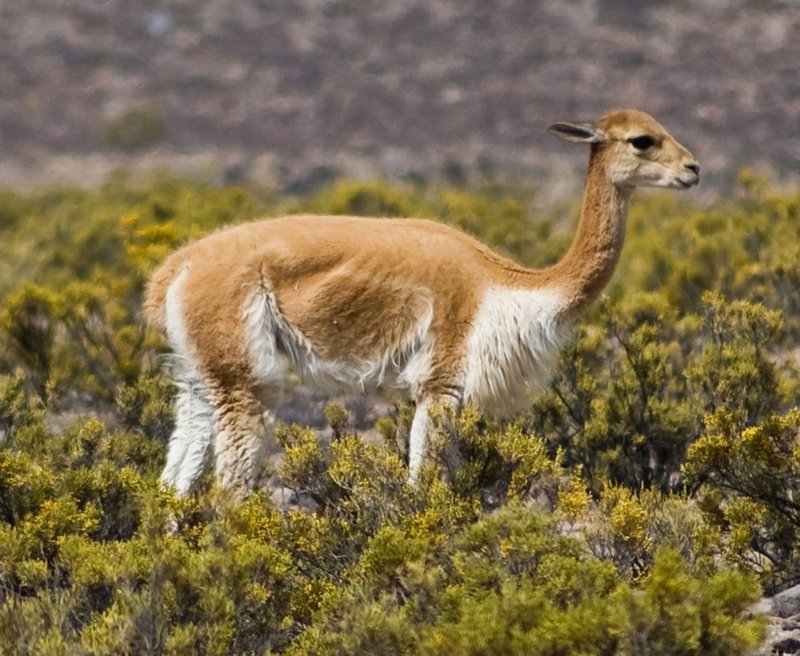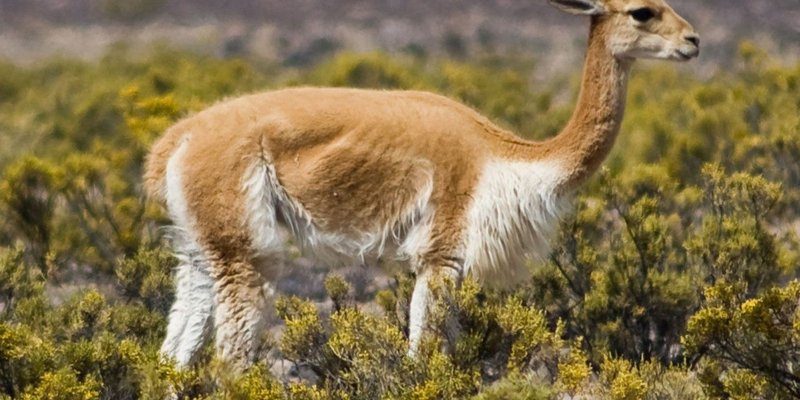
Meet the vicuna, one of the most enchanting creatures of the Andes. Imagine a sleek, graceful animal gracefully darting across the high-altitude plains of South America. With its large, gentle eyes and soft, light-brown fur, it’s no wonder people find them so captivating. These animals are often mistaken for their close relatives, the alpacas and llamas, but there’s much more to them than meets the eye.
Vicunas are not just known for their beauty; they are also remarkable survivors in some of the harshest environments on Earth. Living in elevations that soar above 3,200 meters (10,500 feet), these animals have adapted to the cold, windy conditions that many would find unbearable. Their unique lifestyle and behavior provide a fascinating glimpse into the delicate balance of life in the harsh Andean ecosystem.
Physical Characteristics
When you first see a vicuna, you might be struck by its resemblance to a small llama. These animals typically weigh between 50 to 65 pounds, standing about 3 feet tall at the shoulder. Their fur is incredibly soft and consists of a fine undercoat covered by longer guard hair. This makes vicunas highly sought after for their luxurious wool, which has been prized for centuries. Interestingly, the color of their coat ranges from a rich caramel to a soft fawn, perfectly suited to blend in with their highland environment.
Vicunas possess long legs and a slender body, allowing them to navigate rocky terrain with impressive agility. Their feet are uniquely adapted to provide traction on steep slopes, which can be crucial when escaping predators. Despite their size, vicunas are surprisingly fast, capable of reaching speeds up to 35 miles per hour! This is not just for show; their speed is essential for evading threats like pumas and foxes.
Habitat and Range
The vicuna’s home is primarily found in the high plains, known as the puna, of Bolivia, Peru, Ecuador, and northern Chile. They thrive in elevations ranging from 3,200 to 4,800 meters (10,500 to 15,700 feet) above sea level. The climate in these areas is harsh, characterized by cold temperatures and strong winds. Yet, vicunas have adapted to these conditions remarkably well. Their thick fur keeps them warm during frigid nights, and their bodies are designed to conserve energy in an environment where food can be scarce.
You might be wondering how they survive in such an arid place. Vicunas are browsers, which means they primarily eat grasses and other plants. They have a unique digestive system that allows them to extract maximum nutrients from their food, essential for thriving on the sparse vegetation that characterizes their habitat. Interestingly, they also rely on the moisture from the plants they consume, which helps them stay hydrated.
Diet and Feeding Habits
The diet of a vicuna consists mainly of grasses, which make up about 90% of their intake. They have a selective feeding strategy, often favoring young, tender shoots that are nutrient-rich. Because the puna can be a tough place to find food, vicunas are known to be quite choosy about what they eat. This selectivity is crucial for maintaining their health and ensuring they get enough energy to survive.
Vicunas graze during the cooler parts of the day, typically in the early morning and late afternoon. This not only helps them avoid the worst of the heat but also allows them to conserve water. You might find it fascinating that they can go without drinking for long periods, as they get most of their moisture from the grass they eat. Isn’t nature amazing?
Social Behavior
Vicunas are social animals that live in family groups, typically made up of females and their young. Males usually live alone or in small bachelor groups. This social structure helps them protect each other from predators. When danger approaches, vicunas are known for their strong instincts, often standing together and alerting the group with high-pitched vocalizations. It’s a bit like having a built-in alarm system.
Interesting group dynamics emerge during the mating season. Male vicunas will establish territories and compete for access to females. They mark their territory with scent and will engage in displays of dominance, such as neck wrestling. This behavior is essential for maintaining order in their social structure and ensuring that the strongest males breed.
Reproduction and Lifespan
Vicunas typically reach sexual maturity around 2-3 years of age. The breeding season occurs during the warmer months, usually from late summer to early autumn. After a gestation period of about 11 months, a single cria, or baby vicuna, is born. These young animals are up on their feet within hours and can keep up with the group shortly after birth. It’s a heartwarming sight to see a tiny cria bouncing around, learning the ropes in its new environment.
In the wild, vicunas can live to be 15-20 years old. However, many face threats from habitat loss and poaching for their exquisite wool. Conservation efforts are crucial to ensure that these graceful creatures continue to roam the Andes for generations to come. Protecting vicunas also helps preserve the rich biodiversity of their habitat, which is vital for the entire ecological community.
Conservation Status
Sadly, vicunas are listed as “Least Concern” on the IUCN Red List, but that doesn’t mean their populations are without problems. Historically, they were hunted almost to extinction for their wool, which is considered the finest in the world. Thankfully, international laws and conservation programs have been put in place to protect these animals. Today, vicunas are protected in many countries, and sustainable harvesting programs have been developed to allow for the responsible collection of their wool.
Community involvement is essential in these conservation efforts. Local indigenous groups have taken an active role in protecting vicunas and their habitat, understanding that a healthy vicuna population is also beneficial for their local economies. By promoting ecotourism and sustainable practices, these communities are helping to conserve not only vicunas but the entire Andean ecosystem.
Interesting Facts About Vicunas
| Scientific Name: | Vicugna vicugna |
| Weight: | 50-65 pounds |
| Height: | 3 feet tall at the shoulder |
| Habitat: | High plains of the Andes |
| Diet: | Grasses and vegetation |
| Speed: | Up to 35 miles per hour |
| Lifespan: | 15-20 years |
FAQ
What is a vicuna’s main predator?
Vicunas primarily face threats from carnivores like pumas and foxes. Their natural instinct to flee and their incredible speed help them evade these predators, but they must always be vigilant, especially when grazing or resting. Living in groups provides some protection, as they can alert each other to danger.
Are vicunas endangered?
Vicunas are not considered endangered, but they do face threats from habitat loss and poaching for their valuable wool. Conservation efforts have helped stabilize their populations, but it’s essential to continue protecting their habitats to ensure they thrive. Community programs that involve local people in conservation have shown promising results.
What distinguishes vicunas from llamas and alpacas?
While vicunas are closely related to llamas and alpacas, they are smaller and have finer wool. They also live at higher altitudes compared to their relatives. Unlike llamas and alpacas, which are domesticated, vicunas are wild animals and are known for their wild, graceful nature.
How do vicunas adapt to high altitudes?
Vicunas have several adaptations that allow them to thrive at high altitudes, such as larger lungs and a higher concentration of red blood cells. These features enable them to breathe efficiently and transport oxygen effectively in the thin air of the Andes. Their thick fur also provides insulation against the cold temperatures found at such elevations.
Can vicunas be kept as pets?
While vicunas are beautiful and fascinating, they are not suitable as pets. They are wild animals and require specific care, social structures, and environmental conditions that cannot be easily replicated in a domestic setting. Additionally, it’s illegal to keep vicunas as pets in many countries due to their conservation status.
What role do vicunas play in their ecosystem?
Vicunas play a crucial role in their ecosystem by helping to maintain plant diversity through their selective grazing habits. Their feeding behavior can influence the growth patterns of various plants, contributing to the overall health of the puna ecosystem. As prey for larger predators, they also help sustain the food web in their high-altitude habitat.
How do vicunas communicate with each other?
Vicunas have a range of vocalizations they use to communicate, including high-pitched calls that alert others to danger. Additionally, they utilize body language, such as posturing and physical displays, to express their emotions and intentions, reinforcing their social structures within groups.
What is the significance of vicuna wool?
Vicuna wool is known for its softness and warmth, making it highly prized in the textile industry. It is often referred to as “the fabric of the gods” due to its exceptional quality and rarity. Sustainable harvesting practices have been developed to ensure that vicunas are not harmed while collecting their wool, benefiting both the animals and local communities.
How many vicunas live in the wild today?
Currently, it is estimated that there are around 350,000 vicunas in the wild. Conservation efforts have significantly helped their populations recover from past over-exploitation. However, continuous monitoring and protection of their habitats are necessary to sustain these numbers and ensure their future.
What do vicunas do during the day?
Vicunas are mostly diurnal, meaning they are active during the day. They spend their time grazing, socializing, and resting. Early mornings and late afternoons are prime times for feeding, while the hotter parts of the day are usually spent resting in the shade or finding cooler areas to relax.
How do vicunas impact the economies of local communities?
Vicunas significantly impact local economies through sustainable wool harvesting and ecotourism. By involving communities in conservation efforts, they help create jobs and promote responsible tourism, providing economic incentives for preserving these beautiful animals and their habitats.

